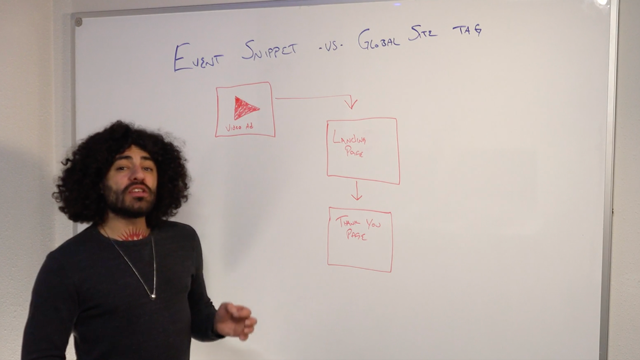 Membership TodaySign Up Now
Membership TodaySign Up NowVideo Transcript:
Components of Google Site Tags
If you run any type of online advertisement, you know that tracking conversions and actually being able to see what’s going on in your campaign is one of the most important things you can do. There are two different components of (Google site tags) a conversion tracking code called the event snippet and the global site tag, and today we’re going to be talking about both of those tags and exactly where to put each so you can effectively track your campaigns. So, let’s go ahead and dive right in.

The Event Snippet and Global Site Tag
My name’s Justin Sardi, I’m the founder and CEO of TubeSift.com, which is a precision targeting tool for YouTube advertisers, and today we’re going to talk all about how to track conversions on Google Ads and what the difference between the event snippet and the global site tag is. So traditionally, what you’re going to have, and this is like the most basic type of ad funnel, if you will, you’re basically going to have a video ad, if you’re running an ad on YouTube, and that’s going to be pushing to a landing page. So your viewer, your video ad is shown to targeted prospects, which you can use TubeSift to find very easily, showing targeted prospects. Ideally, they click on your video ad and they’re taken to your landing page.
Now, a landing page could be a sales page, an opt-in page, whatever you want it to be. But basically, they hit your landing page and you probably want to either collect a lead or make a sale, for the most part, and that’s what we’re going to be running with on this example here. So, ideally, somebody sees our video ad, they go to our landing page, they purchase, they take action, they hit our thank-you page. Now, obviously you can do some retargeting, all that kind of stuff, but ideally this is the perfect flow. That would be great if everybody who saw the video ad went to the landing page, went to the thank-you page.
Using Conversion Tracking
So, how do we actually track who went from the video ad to the thank-you page? Well, we’re going to use conversion tracking. We have a full blog post on how to set all of this up, but today I’m going to be breaking down the difference between the event snippet and the global site tag. So when you are setting these up on Google or in Google Ads, you’re going to go to your conversions box or your conversions menu, you’re going to set up a conversion. And when you set up a conversion, this one we might call something like, “makes a purchase” or whatever. They’re going to give you two separate snippets of code. One is going to be the event snippet, and the other one is going to be the global site tag.
Now, the global site tag and the event snippet work together to create a conversion tracking pixel or a conversion tracking code. The thank-you page is the page that we want to track. We know that if somebody hits our thank you page, they have taken our desired action. So they’ve opted in, they’ve purchased, something along those lines. The only way that anybody’s going to see this thank-you page is if they’ve taken our desired action on our landing page. So, this thank-you page gets the event snippet and the global site tag, and those all go in the head of the page. We have a whole blog post talking about that. I’ll link to that below. But event snippet and a global site tag is exactly what you need on this page.
Creating Retargeting Lists from the Global Site Tag
Now, the landing page, if we want to retarget, and this is the most common problem that I see, a lot of people will put the global site tag on their land page which is perfect. The global site tag will allow you to create retargeting lists, and that’s great because if somebody doesn’t, ideally they say yes to our offer, right? Yes. That’s not how you spell yes. There we go. Ideally, they say yes to our offer and they are taken to our thank-you page. But sometimes, they’re going to say no, in which case we want to add them to a retargeting list, and then that retargeting list, we could run ads again and push them back to the landing page.
But the way to create those retargeting lists is by using the global site tag. So, the global site tag and the event snippet, together, is the conversion tracking code. The global site tag alone will not track conversions. You need an event snippet to go with that, to make it track conversions. Now, the global site tag, like I said, you can set up retargeting audiences, and we have another blog post on that as well so you definitely check that out, but that global site tag just goes on the landing page and it’s not going to track any conversions, anything like that, unless you add the event snippet with it.

The Conversion Tracking Pixel
So, essentially, put the two together, you have a conversion tracking pixel. And you leave them apart, like the global site tag by itself, you have a retargeting pixel. If you have the event snippet on a page by itself, it is not going to work. It has to go together with the global site tag, and Google ads is going to know that and be able to track conversions that way.
So, that is the difference between an event snippet and a global site tag. They are both snippets of code that go in the head of your page, but together, they create a conversion tracking pixel. And if you do put them together here, on your landing page, it’s going to show every single click as a conversion, and you don’t want to do that. You only want the event snippet on the page that you are actually trying to track for a conversion.
So that’s it for me on this video. If you did like this one, give us the thumbs up, leave us a comment. And as always, you can jump over to TubeSift.com and sign up for a TubeSift membership. That’s going to help you get your video ads shown to very specific people who want exactly what you have to offer and want it at the exact moment that you are able to show them your ad. So that’s it for me on this one. Bye for now.
 Membership TodaySign Up Now
Membership TodaySign Up NowResources:
- Retargeting vs. Remarketing from the TubeSift Blog
- Retargeting with Google Ads from the TubeSift Blog
- How to Advertise on Top YouTube Channels from the TubeSift Blog
- Use the Global Site Tag for Google Ads Conversion Tracking from Google Ads Help



Comments are closed.